Kathleen "Betty" S. Anderson
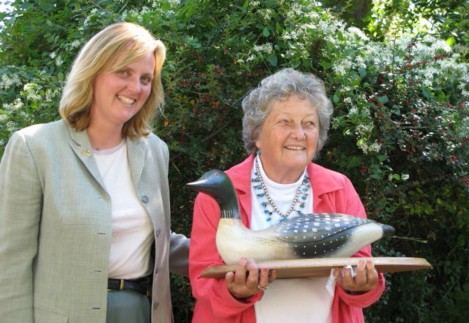
Betty Anderson (right) receives Mass Wildlife’s Francis W. Sargent Conservation Award on September 10, 2007. With Mary Griffin (left), Commissioner of the Massachusetts Department of Fish and Game. Photograph by Wayne R. Petersen.
The Making of a List-keeping Birder
My parents were country people. My maternal grandparents were pioneer cattle ranchers in Montana, and my mother grew up in a log house along the Big Elk River in the foothills of the Crazy Mountains in south-central Montana. Wolves, coyotes, elk, antelope, and mountain lions, along with deer, jackrabbits, badgers, and smaller critters, all were part of her childhood.
My father grew up near Boston, Massachusetts, but loved the outdoors from childhood; he was an excellent naturalist. One of his vivid memories as a young man was having climbed Mount Katahdin in Maine for the first time and seeing his first caribou standing on the peak. He was homesteading in southwestern Colorado when he became one of the first forest rangers to be appointed to the newly founded United States Forest Service. He spent the next 15 years working for the Forest Service, during which time he met Gifford Pinchot, Ferdinand Silcox, and President Theodore Roosevelt—the three men responsible for its establishment. When I was a child, it seemed to me that my father knew the names of and information about every plant, animal, bird, and reptile we ever saw.
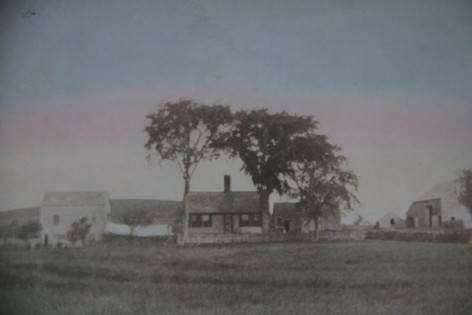
Wolf Trap Hill and the circa-1735 house photographed in 1881. Photograph courtesy of Kathleen Brissette.
My youngest brother, my sister, and I grew up on 17 acres of gardens, orchards, and cranberry bogs on a large freshwater lake in Massachusetts. My father and our eldest half-brother built us a fine clay tennis court, my father built a rowboat, and Brad—that beloved half-brother—found us a well-used but sturdy sailboat. What a childhood—swimming, sailing, and tennis in summer, and ice-skating and bonfires for hotdogs in winter. It was only many years later that we realized we had so much, for we were not wealthy. But build a better mousetrap and they will come. All of our school friends wanted to share our plenty. Only years later did we realize some people called our home “the country club of Carver.”
As often as our parents could manage it, we drove out west in summer, camping all the way—a matter of economies, I know now. The main destination was our grandparents’ ranch in Montana. Mother grew up there in a family of eight children. My grandparents had four children of their own and raised another four motherless children—showing no favoritism—providing my generation with many aunts and uncles and even more cousins. I have wonderful memories of horseback riding, cattle drives, picnics in Big Timber Canyon, fishing in the creek, butter churning, and dishwashing that seemed to go on for hours. The ranch was a busy place and in the summer all of the children our grandparents had raised came and went. I still marvel that our seemingly tireless grandparents welcomed us all.
My interest in birds kept growing with every year since before I can remember. I still can recall the first trip west when I saw my first adult Red-headed Woodpecker on a roadside fence post in Iowa. The sighting went into a little trip notebook that I was keeping, followed by those big black and white magpies and Western Meadowlarks with their beautiful song.
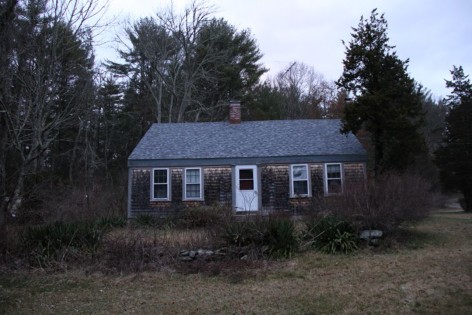
The circa-1735 house as it appeared on January 1, 2016. Photograph by Wayne R. Petersen.
The many new birds in that notebook was the spur I needed to hunt for every bird I could find on our home property, and soon I was adventuring into every bit of woodland within walking distance. The list kept growing. My father encouraged me and even as busy as he was, he took me to places such as Plymouth Beach, Manomet Point, and the Cape Cod Canal and the list grew longer. My father had an old pair of 4x field glasses that one of his uncles had carried during the Civil War. As I grew into my teens and became seriously interested in birds, I was permitted to use those glasses. We didn’t travel every summer, but in the years we didn’t head west, we often spent several days camping in the three northern New England states. The well-loved field glasses were always with me and my bird list was growing.
Years went by, I grew up, married my husband Paul, and lived in Worcester, Massachusetts; Poplar and Roundup, Montana; and moved back to Middleborough, Massachusetts. We had been living in Montana until Paul’s mother’s health problems convinced him we should return to Massachusetts, where a job was waiting for him. We settled into an apartment in Middleborough, his hometown. Apartment living in “downtown” Middleborough was too noisy and confining after the wide open spaces of Big Sky Country. We turned to Paul’s uncle, a realtor, who was soon showing us small houses on small lots uptown or small houses on larger lots along Route 28, ignoring my continuing complaint that we wanted a place in the country.
Eventually he gave in: “Okay, kids, I’ll show you a place in that country! I’ve had it listed for two years but no one will ever buy a place like that!”
We left town, crossed Route 44 and headed north on Thompson Street, turning right onto a long gravel road, right onto a shorter gravel road, then down a long unpaved driveway with overgrown pastures on either side. Finally, at the end of the lane was a little old Cape Cod house with weathered gray shingles. Even before we entered the house, we knew the location was just what we were looking for. The house had new wallpaper on the first floor, a relatively modern kitchen, a living room with a fireplace, a bathroom, and a large bedroom with a small room beside it, just right for two-year-old Tim. Two small bedrooms were tucked under the eaves at the top of a steep narrow staircase. Naïve as we were, the water pump and furnace in the cellar received only casual glances. Old houses always conceal surprises, but we knew we had found the right place for us.
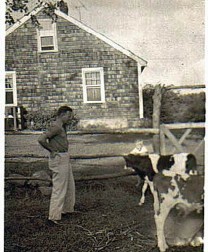
Paul Anderson at Wolf Trap Hill Farm in the 1950s. Photograph courtesy of Kathleen Brissette.
According to the official history of Middleborough, Massachusetts, the hill just north of our house is called Wolf Trap Hill because early settlers, having problems with wolves that killed their sheep, dug a deep trench across the Indian trail that connected Patuxet (Plymouth) with Nemasket (Middleborough). The legend states that the morning after the trench was dug, they found an Indian at one end and a wolf at the other end—both alive, as implausible as that seems to me. What else could we call our new home but Wolf Trap Hill Farm?
When Paul and I and our two-year-old son moved into the circa-1735 farm house on November 30, 1950, I would not have believed that I would still be living here 65 years later in 2015. At the time, I still hoped I could convince Paul to return to my beloved Montana where I was born. Obviously I failed. I’ve lost Paul, and our two children are married and living in homes of their own. In 2015, Wolf Trap Hill Farm remains an important part of my life. I only occasionally think of living permanently in Montana.
As we were carrying in our few possessions with the help of my brother and brother-in-law that cold November day, I noticed a junco in the lilacs and decided to make a note of it and any other birds I saw while we were living here.
Biodiversity at Wolf Trap Hill
The days and years flew by. We purchased a large wood lot that abutted our 27 acres, then bought 10 additional acres of the adjoining Little Cedar Swamp, bringing our total to 104 acres. When the Wildlands Trust of southeastern Massachusetts began to acquire Little Cedar Swamp, I added my 10 acres to their acquisitions, leaving Wolf Trap Hill Farm with 94 acres of gardens, pastures, and a woodland of white pines, white oaks, red maples, and a variety of other trees and shrubs. The old stone walls that form squares back in the woods prove that the land had been cleared historically and was once a self-sufficient little farm.
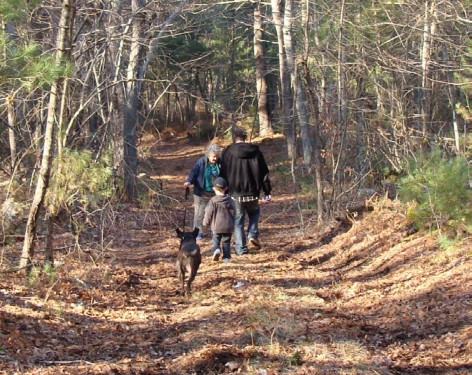
Betty with visitors. Photograph by Kathleen Brissette.
Beginning with that junco, I kept track of every living critter I could identify on Wolf Trap Hill Farm, not just birds but also mammals, amphibians, reptiles, insects, plants—anything I was certain I was naming correctly. And the lists keep growing, categorized by date and place.
The most unusual mammal on the list so far is moose. I didn’t exactly see the moose, but my daughter Kathleen found some scat one day that neither of us recognized. I bagged it and brought it to the next meeting of the advisory board of the Massachusetts Natural Heritage and Endangered Species Program, where other members identified it for me as moose scat.
I’m predicting—hoping—that black bear will be the next mammal, because they are increasing all over Massachusetts and spreading into the southeastern part of the Commonwealth. I’m not sure I want to be alone far back in the woods when I see my first bear. Perhaps I’ll see one from the kitchen window some morning as I glance at the birdfeeders.
My most unusual amphibian is a four-toed salamander that I found under sphagnum moss in the Atlantic white cedar swamp. My most recent addition, seen on July 20, 2015, is a tiny butterfly with the imposing name of tawny emperor.
The fanciest, least-expected bird landed on my list on July 8, 2014, as I was sitting out on the lawn with binoculars on my lap—luckily for me—when a shadow passed over. I glanced up to see an all black raptor gliding down across the lawn near me to perch in a white pine along the driveway. We don’t have any all black buteos in Massachusetts. My first thought was, “What in hell is that?” I kept my binoculars on it until it lifted off to fly west across the pastures and out of sight. Then I dashed for the field guide on the kitchen table. There was nothing it could be but a Zone-tailed Hawk, “rare in southern California and southern Texas” according to the National Geographic Field Guide to the Birds of North America! I could hardly believe what I had seen. And I still wonder if even my good friend Wayne Petersen would have believed me if anyone but David Ludlow had not been driving through North Carver near the intersection of Route 58 and Route 44 when he saw a large black buteo over the highway. He had already decided that it had to be a Zonetail before he heard about my sighting. We later figured he had probably seen it about 15 minutes earlier, flying northwest toward East Middleborough, which brought it over Wolf Trap Hill.
My Wolf Trap Hill List
The list that began with one junco now stands at:
35 mammals out of circa 50 land mammals known for Massachusetts, approximately three-quarters
193 birds out of approximately 500 known birds of Massachusetts, about two-fifths
25 herps (reptiles and amphibians) out of 46 known for Massachusetts, more than half
47 butterflies of 103 known for Massachusetts, almost half 30 dragonflies of 106 of Massachusetts, over one-fifth
I am all too aware that this is bragging on my part, but my hope is that it may encourage some of the rest of you to look more closely at your “patch,” however large or small it may be. You might not find a moose or a Zone-tailed Hawk—my “biggies” so far—but you will find your own special birds and other creatures.
Every day is a gift, and some of the dearest are the nearest.
Kathleen “Betty” S. Anderson was the ornithologist at the Massachusetts Department of Public Health’s Encephalitis Field Station for 11 years. She left to join the Manomet Bird Observatory (now Manomet, Inc.) as the Founding Director, a position she held for fifteen years. She currently chairs the Massachusetts Natural Heritage & Endangered Species Advisory Committee. Betty continues to research the biodiversity at Wolf Trap Hill Farm.